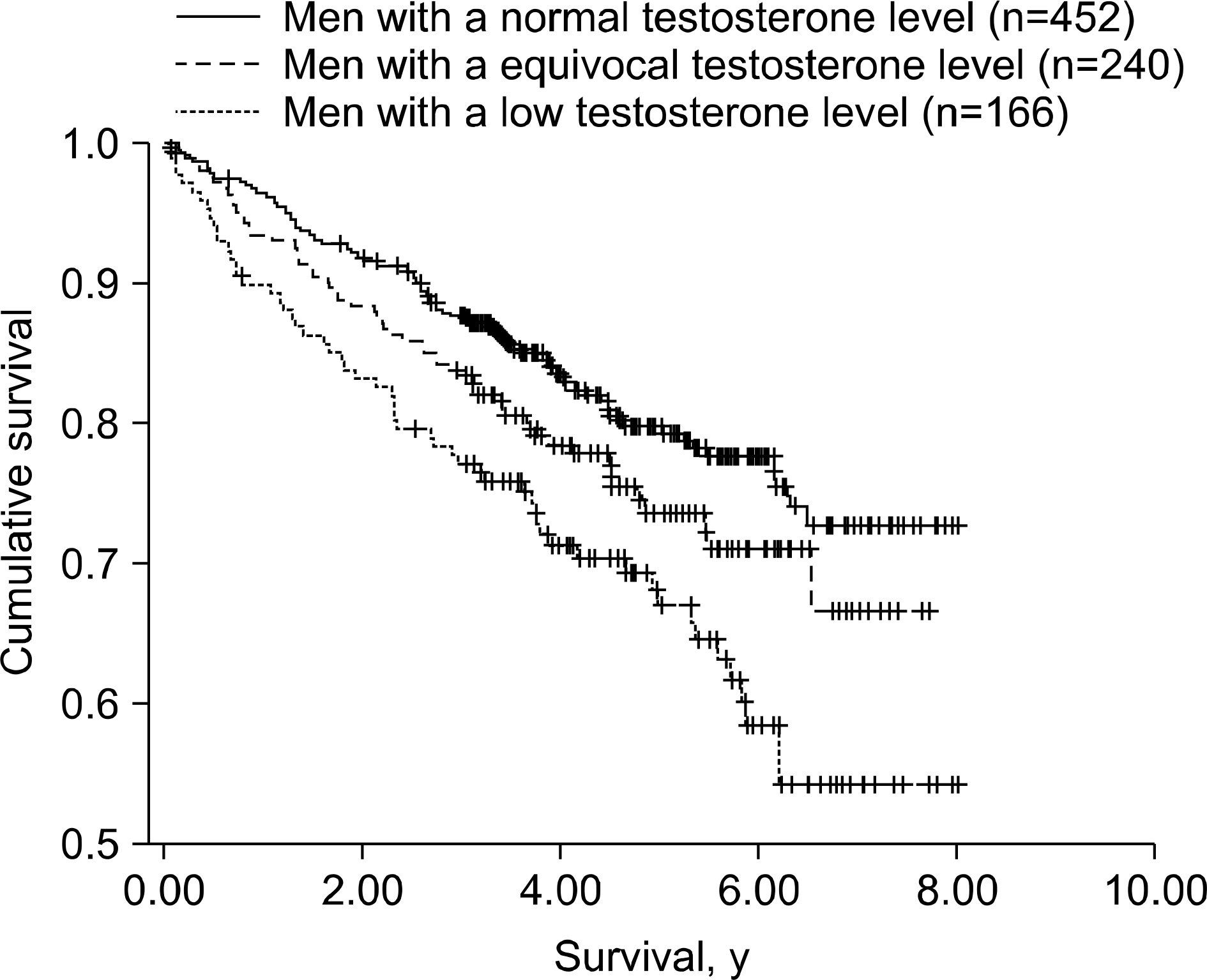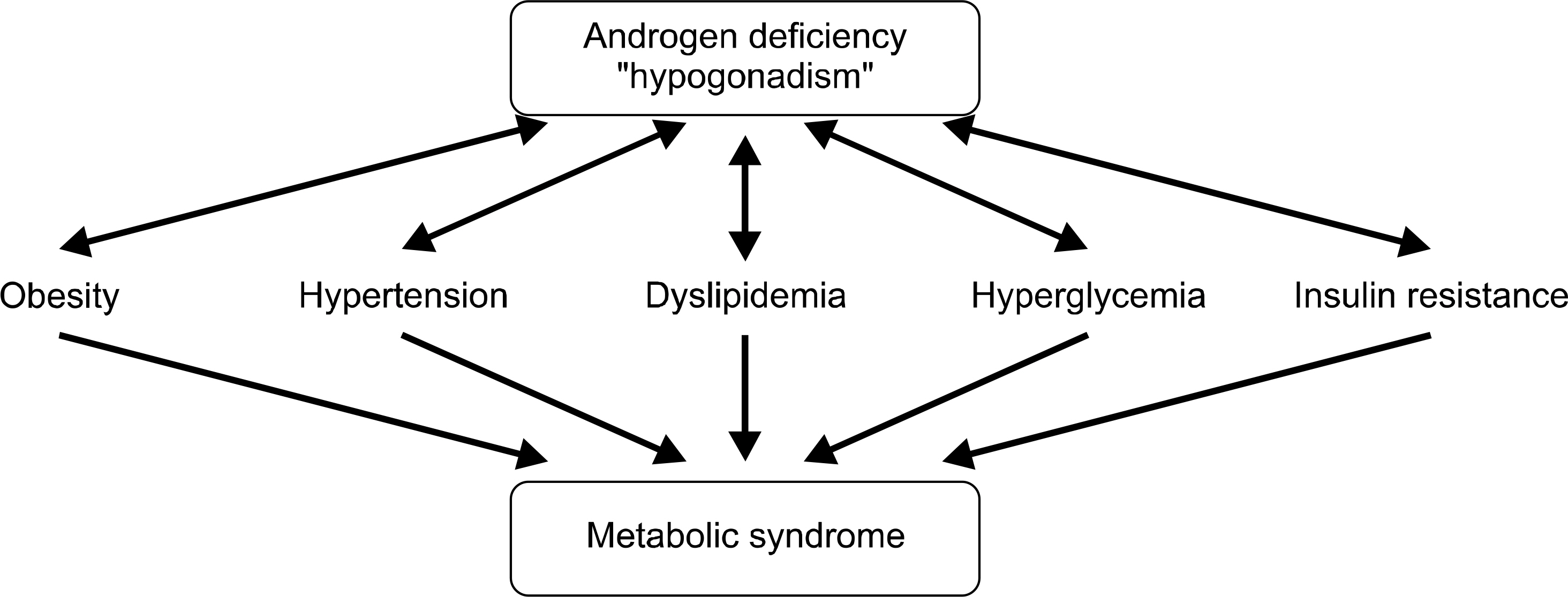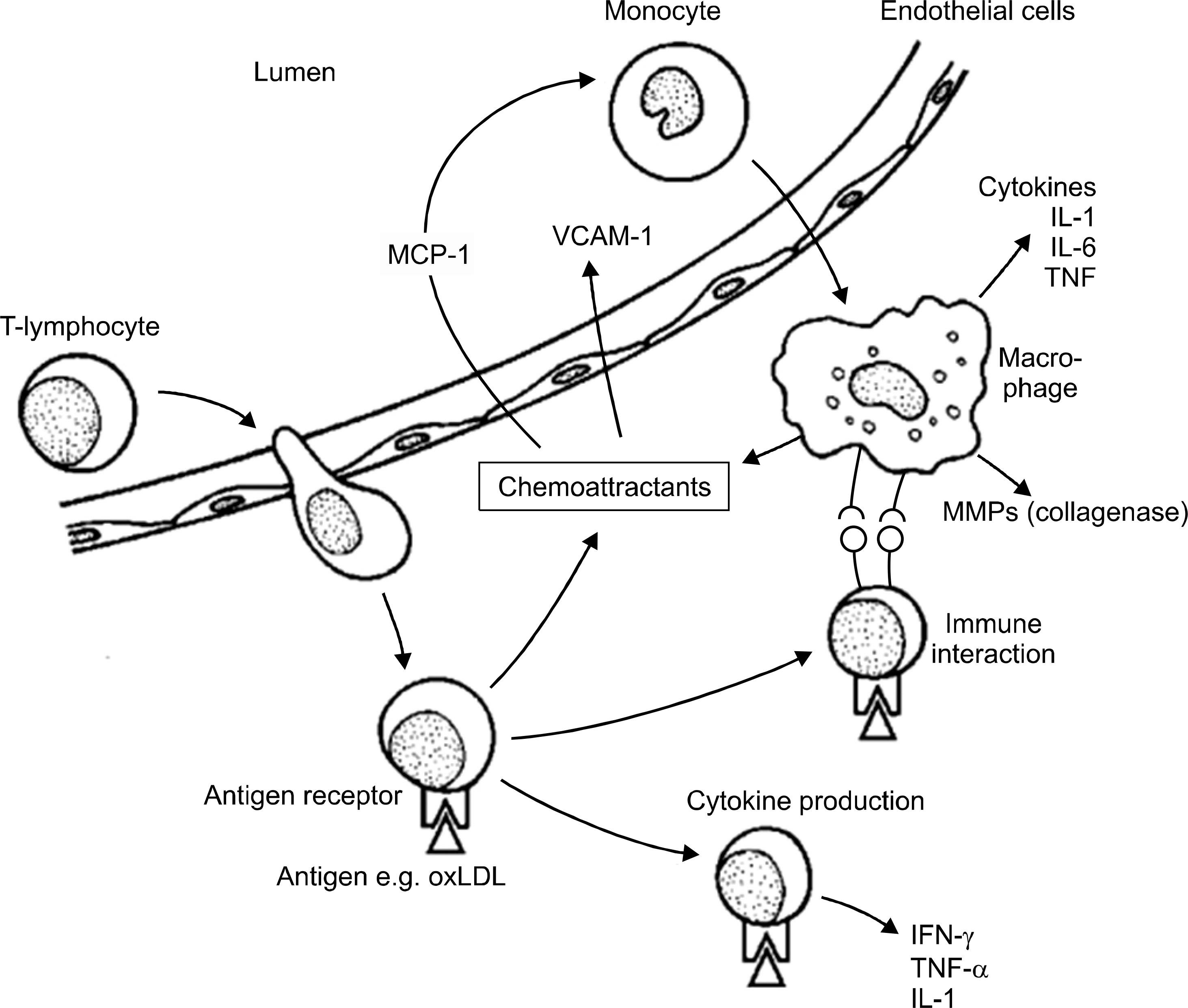Korean J Androl.
2011 Apr;29(1):10-20. 10.5534/kja.2011.29.1.10.
Effects of Androgen on the Cardiovascular System in the Aging Male
- Affiliations
-
- 1Department of Urology, Korea University College of Medicine, Korea University Institute for Regenerative Medicine, Seoul, Korea. dgmoon@korea.ac.kr
- KMID: 2298621
- DOI: http://doi.org/10.5534/kja.2011.29.1.10
Abstract
- Testosterone decrease in men with age has become well established. As such, several modes of testosterone replacement therapy have become available, primarily for supplementation to alleviate the effects of age associated hypogonadism, as manifested by frailty, sarcopenia, poor muscle quality, decreased libido and erectile functions. Recent investigations have found significant association between hypogonadism and cardiovascular disease, type 2 diabetes, obesity and dyslipidemia. The association is more clearly presented in patients receiving androgen deprivation therapy for prostate cancer. Furthermore, testosterone supplementation restores arterial vasoreactivity, reduces proinflammatory cytokines, total cholesterol, and triglyceride levels, and improves endothelial function and insulin sensitivity. Future long term trials should be performed to identify persistent benefits and safety of this treatment.
Keyword
MeSH Terms
Figure
Reference
-
1). Shores MM, Matsumoto AM, Sloan KL, Kivlahan DR. Low serum testosterone and mortality in male veterans. Arch Intern Med. 2006; 166:1660–5.
Article2). Araujo AB, O'Donnell AB, Brambilla DJ, Simpson WB, Longcope C, Matsumoto AM, et al. Prevalence and incidence of androgen deficiency in middle-aged and older men: estimates from the Massachusetts Male Aging Study. J Clin Endocrinol Metab. 2004; 89:5920–6.
Article3). Rhoden E, Morgentaler A. Risks of testosterone-replacement therapy and recommendations for monitoring. N Engl J Med. 2004; 350:482–92.
Article4). Bain J. Testosterone and the aging male: to treat or not to treat? Maturitas. 2010; 66:16–22.
Article5). Foreman MD. Cardiovascular disease. A men's health hazard. Nurs Clin North Am. 1986; 21:65–73.6). Kalin M, Zumoff B. Sex hormones and coronary disease: a review of the clinical studies. Steroids. 1990; 55:330–52.
Article7). Assmann G, Lewis B, Mancini M. The recognition and management of hyperlipidaemia in adults: a policy statement of the European Atherosclerosis Society. Eur Heart J. 1988; 9:571–600.8). Nj⊘lstad I, Arnesen E, Lund-Larsen PG. Smoking, serum lipids, blood pressure, and sex differences in myocardial infarction: a 12-year follow-up of the Finnmark Study. Circulation. 1996; 93:450–6.9). Gordon T, Kannel W, Hjortland M, McNamara P. Menopause and coronary heart disease. The Framingham Study. Ann Intern Med. 1978; 89:157–61.
Article10). Stampfer M, Colditz G, Willett W, Manson J, Rosner B, Speizer F, et al. Postmenopausal estrogen therapy and cardiovascular disease: ten-year follow-up from the Nurses' Health Study. N Engl J Med. 1991; 325:756–62.11). Shabsigh R, Katz M, Yan G, Makhsida N. Cardiovascular issues in hypogonadism and testosterone therapy. Am J Cardiol. 2005; 96:67M–72M.
Article12). Wu FC, von Eckardstein A. Androgens and coronary artery disease. Endocr Rev. 2003; 24:183–217.
Article13). Levy D, Kannel WB. Searching for answers to ethnic disparities in cardiovascular risk. Lancet. 2000; 356:266–7.
Article14). Traish AM, Saad F, Feeley RJ, Guay A. The dark side of testosterone deficiency: III. Cardiovascular disease. J Androl. 2009; 30:477–94.
Article15). Traish AM, Guay A, Feeley R, Saad F. The dark side of testosterone deficiency: I. Metabolic syndrome and erectile dysfunction. J Androl. 2009; 30:10–22.
Article16). Makinen J, Jarvisalo MJ, Pollanen P, Perheentupa A, Irjala K, Koskenvuo M, et al. Increased carotid atherosclerosis in andropausal middle-aged men. J Am Coll Cardiol. 2005; 45:1603–8.
Article17). Simon D, Charles MA, Nahoul K, Orssaud G, Kremski J, Hully V, et al. Association between plasma total testosterone and cardiovascular risk factors in healthy adult men: The Telecom Study. J Clin Endocrinol Metab. 1997; 82:682–5.
Article18). Kapoor D, Malkin CJ, Channer KS, Jones TH. Androgens, insulin resistance and vascular disease in men. Clin Endocrinol (Oxf). 2005; 63:239–50.
Article19). Grossmann M, Thomas M, Panagiotopoulos S, Sharpe K, MacIsaac R, Clarke S, et al. Low testosterone levels are common and associated with insulin resistance in men with diabetes. J Clin Endocrinol Metab. 2008; 93:1834–40.
Article20). Kapoor D, Aldred H, Clark S, Channer K, Jones T. Clinical and biochemical assessment of hypogonadism in men with type 2 diabetes. Diabetes Care. 2007; 30:911–7.
Article21). Pasquali R. Obesity and androgens: facts and perspectives. Fertil Steril. 2006; 85:1319–40.
Article22). Chandel A, Dhindsa S, Topiwala S, Chaudhuri A, Dandona P. Testosterone concentration in young patients with diabetes. Diabetes Care. 2008; 31:2013–7.
Article23). Phillips G. Relationship between serum sex hormones and glucose, insulin and lipid abnormalities in men with myocardial infarction. Proc Natl Acad Sci USA. 1977; 74:1729–33.
Article24). Selva D, Hogeveen K, Innis S, Hammond G. Monosaccharide-induced lipogenesis regulates the human hepatic sex hormone-binding globulin gene. J Clin Invest. 2007; 117:3979–87.
Article25). Zitzmann M, Gromoll J, Von Eckardstein A, Nieschlag E. The CAG repeat polymorphism in the androgen receptor gene modulates body fat mass and serum concentrations of leptin and insulin in men. Diabetologia. 2003; 46:31–9.
Article26). Laaksonen D, Niskanen L, Punnonen K, Nyyssönen K, Tuomainen T, Valkonen V, et al. Testosterone and sex hormone-binding globulin predict the metabolic syndrome and diabetes in middle-aged men. Diabetes Care. 2004; 27:1036–41.
Article27). Strain GW, Zumoff B, Miller LK, Rosner W, Levit C, Kalin M, et al. Effect of massive weight loss on hypothalamic-pituitary-gonadal function in obese men. J Clin Endocrinol Metab. 1988; 66:1019–23.28). Zumoff B. Hormonal abnormalities in obesity. Acta Med Scand Suppl. 1988; 723:153–60.
Article29). Hammoud AO, Gibson M, Peterson CM, Hamilton BD, Carrell DT. Obesity and male reproductive potential. J Androl. 2006; 27:619–26.
Article30). Schneider G, Kirschner MA, Berkowitz R, Ertel NH. Increased estrogen production in obese men. J Clin Endocrinol Metab. 1979; 48:633–8.
Article31). Smith EP, Boyd J, Frank GR, Takahashi H, Cohen RM, Specker B, et al. Estrogen resistance caused by a mutation in the estrogen-receptor gene in a man. N Engl J Med. 1994; 331:1056–61.
Article32). Carani C, Qin K, Simoni M, Faustini-Fustini M, Serpente S, Boyd J, et al. Effect of testosterone and estradiol in a man with aromatase deficiency. N Engl J Med. 1997; 337:91–5.
Article33). Khaw KT, Dowsett M, Folkerd E, Bingham S, Wareham N, Luben R, et al. Endogenous testosterone and mortality due to all causes, cardiovascular disease, and cancer in men: European prospective investigation into cancer in Norfolk (EPIC-Norfolk) Prospective Population Study. Circulation. 2007; 116:2694–701.34). Van Pottelbergh I, Braeckman L, De Bacquer D, De Backer G, Kaufman JM. Differential contribution of testosterone and estradiol in the determination of cholesterol and lipoprotein profile in healthy middle-aged men. Atherosclerosis. 2003; 166:95–102.
Article35). Smith MR. Changes in body composition during hormonal therapy for prostate cancer. Clin Prostate Cancer. 2003; 2:18–21.
Article36). Smith MR, Lee H, Nathan DM. Insulin sensitivity during combined androgen blockade for prostate cancer. J Clin Endocrinol Metab. 2006; 91:1305–8.
Article37). Braga-Basaria M, Dobs AS, Muller DC, Carducci MA, John M, Egan J, et al. Metabolic syndrome in men with prostate cancer undergoing longterm androgen-deprivation therapy. J Clin Oncol. 2006; 24:3979–83.
Article38). Basaria S, Muller D, Carducci M, Egan J, Dobs A. Hyperglycemia and insulin resistance in men with prostate carcinoma who receive androgen deprivation therapy. Cancer. 2006; 106:581–8.39). Keating NL, O'Malley AJ, Freedland SJ, Smith MR. Diabetes and cardiovascular disease during androgen deprivation therapy: observational study of veterans with prostate cancer. J Natl Cancer Inst. 2010; 102:39–46.
Article40). Shahani S, Braga-Basaria M, Basaria S. Androgen deprivation therapy in prostate cancer and metabolic risk for atherosclerosis. J Clin Endocrinol Metab. 2008; 93:2042–9.
Article41). Malkin CJ, Pugh PJ, Morris PD, Kerry KE, Jones RD, Jones TH, et al. Testosterone replacement in hypogonadal men with angina improves ischaemic threshold and quality of life. Heart. 2004; 90:871–6.
Article42). Lesser M. Testosterone propionate therapy in one hundred cases of angina pectoris. J Clin Endocrinol Metab. 1946; 6:549–57.
Article43). Chou TM, Sudhir K, Hutchison SJ, Ko E, Amidon TM, Collins P, et al. Testosterone induces dilation of canine coronary conductance and resistance arteries in vivo. Circulation. 1996; 94:2614–9.
Article44). Jones RD, Pugh PJ, Jones TH, Channer KS. The vasodilatory action of testosterone: a potassium channel opening or a calcium antagonistic action? Br J Pharmacol. 2003; 138:733–44.45). Hall J, Jones RD, Jones TH, Channer KS, Peers C. Selective inhibition of L-type Ca2+ channels in A7r5 cells by physiological levels of testosterone. Endocrinology. 2006; 147:2675–80.
Article46). Webb CM, McNeill JG, Hayward CS, de Zeigler D, Collins P. Effects of testosterone on coronary vasomotor regulation in men with coronary heart disease. Circulation. 1999; 100:1690–6.
Article47). Ikonomidis I, Andreotti F, Economou E, Stefanadis C, Toutouzas P, Nihoyannopoulos P. Increased proinflammatory cytokines in patients with chronic stable angina and their reduction by aspirin. Circulation. 1999; 100:793–8.
Article48). Manten A, de Winter RJ, Minnema MC, ten Cate H, Lijmer JG, Adams R, et al. Procoagulant and proinflammatory activity in acute coronary syndromes. Cardiovasc Res. 1998; 40:389–95.
Article49). Falk E, Shah PK, Fuster V. Coronary plaque disruption. Circulation. 1995; 92:657–71.
Article50). Malkin CJ, Pugh PJ, Jones RD, Jones TH, Channer KS. Testosterone as a protective factor against atherosclerosis–immunomodulation and influence upon plaque development and stability. J Endocrinol. 2003; 178:373–80.
Article51). Yesilova Z, Ozata M, Kocar IH, Turan M, Pekel A, Sengul A, et al. The effects of gonadotropin treatment on the immunological features of male patients with idiopathic hypogonadotropic hypogonadism. J Clin Endocrinol Metab. 2000; 85:66–70.
Article52). Hak AE, Witteman JC, de Jong FH, Geerlings MI, Hofman A, Pols HA. Low levels of endogenous androgens increase the risk of atherosclerosis in elderly men: the Rotterdam study. J Clin Endocrinol Metab. 2002; 87:3632–9.
Article53). Hatakeyama H, Nishizawa M, Nakagawa A, Nakano S, Kigoshi T, Uchida K. Testosterone inhibits tumor necrosis factor-alpha-induced vascular cell adhesion molecule-1 expression in human aortic endothelial cells. FEBS Lett. 2002; 530:129–32.54). Kapoor D, Goodwin E, Channer KS, Jones TH. Testosterone replacement therapy improves insulin resistance, glycaemic control, visceral adiposity and hypercholesterolaemia in hypogonadal men with type 2 diabetes. Eur J Endocrinol. 2006; 154:899–906.
Article55). Kalinchenko SY, Tishova YA, Mskhalaya GJ, Gooren LJG, Giltay EJ, Saad F. Effects of testosterone supplementation on markers of the metabolic syndrome and inflammation in hypogonadal men with the metabolic syndrome: the double blinded placebo controlled Moscow study. Clin Endocrinol (Oxf). 2010; 73:602–12.56). Wang C, Cunningham G, Dobs A, Iranmanesh A, Matsumoto AM, Snyder PJ, et al. Longterm testosterone gel (AndroGel) treatment maintains beneficial effects on sexual function and mood, lean and fat mass, and bone mineral density in hypogonadal men. J Clin Endocrinol Metab. 2004; 89:2085–98.
Article57). Isidori AM, Giannetta E, Greco EA, Gianfrilli D, Bonifacio V, Isidori A, et al. Effects of testosterone on body composition, bone metabolism and serum lipid profile in middle-aged men: a meta-analysis. Clin Endocrinol (Oxf). 2005; 63:280–93.
Article58). Dobs AS, Bachorik PS, Arver S, Meikle AW, Sanders SW, Caramelli KE, et al. Interrelationships among lipoprotein levels, sex hormones, anthropometric parameters, and age in hypogonadal men treated for 1 year with a permeation-enhanced testosterone transdermal system. J Clin Endocrinol Metab. 2001; 86:1026–33.
Article59). Hong ES, Kim SY, Choi YJ, Kim SW, Shin CS, Park KS, et al. The effects on visceral fat and cardiovascular risk factors of testosterone replacement in secondary hypogonadal men. Endocrinol Metab. 2005; 20:252–60.
Article60). Mathur A, Malkin C, Saeed B, Muthusamy R, Jones TH, Channer K. Longterm benefits of testosterone replacement therapy on angina threshold and atheroma in men. Eur J Endocrinol. 2009; 161:443–9.
Article61). Boyanov MA, Boneva Z, Christov VG. Testosterone supplementation in men with type 2 diabetes, visceral obesity and partial androgen deficiency. Aging Male. 2003; 6:1–7.
Article62). Moon du G, Park MG, Lee SW, Park K, Park JK, Kim SW, et al. The efficacy and safety of testosterone undecanoate (Nebido®) in testosterone deficiency syndrome in Korean: a multicenter prospective study. J Sex Med. 2010; 7:2253–60.63). Saad F, Gooren LJ. The role of testosterone in the etiology and treatment of obesity, the metabolic syndrome, and diabetes mellitus type 2. J Obes. 2011; 2011:pii: 471584. Epub 2010 Aug 10.
Article





